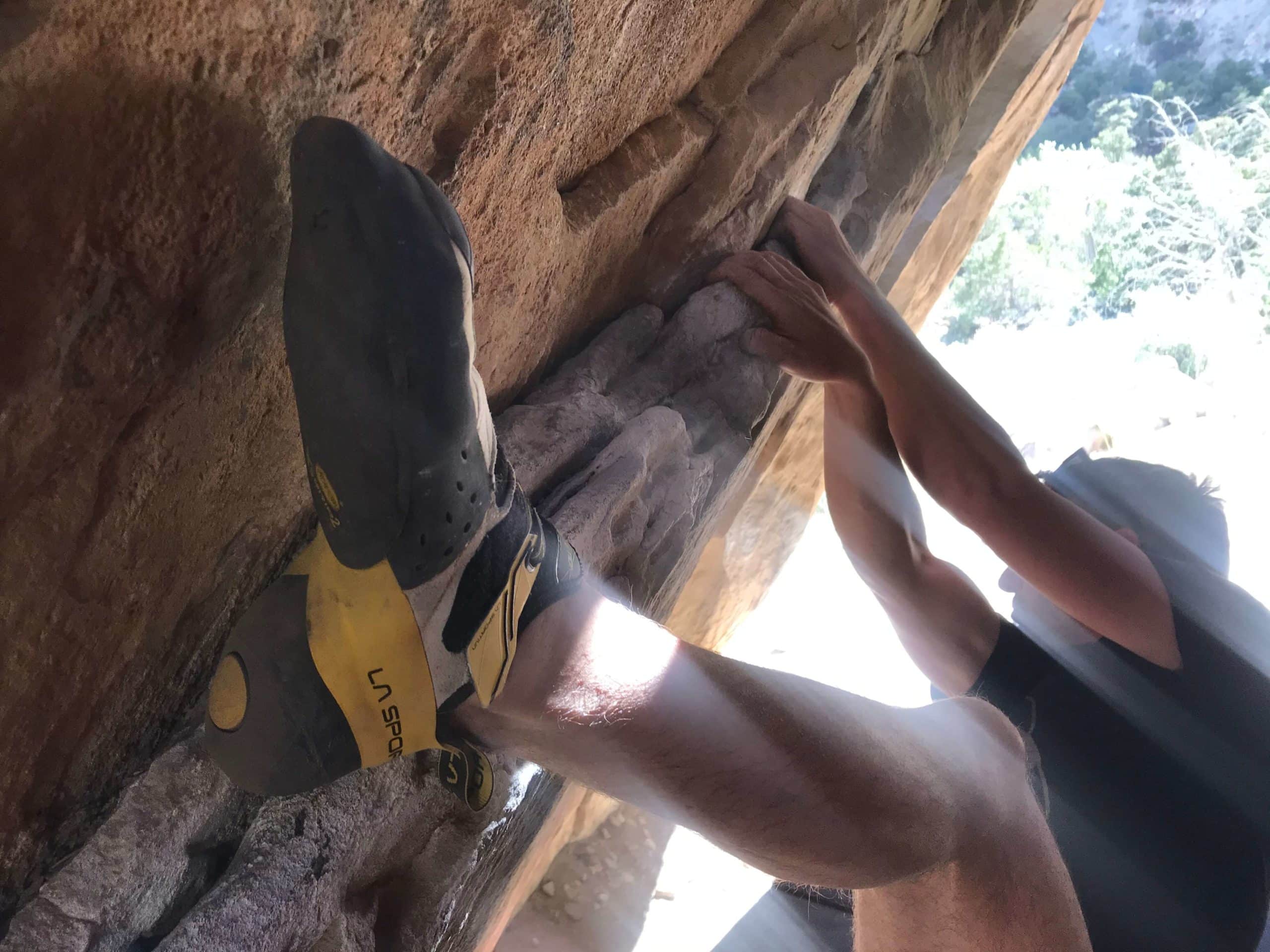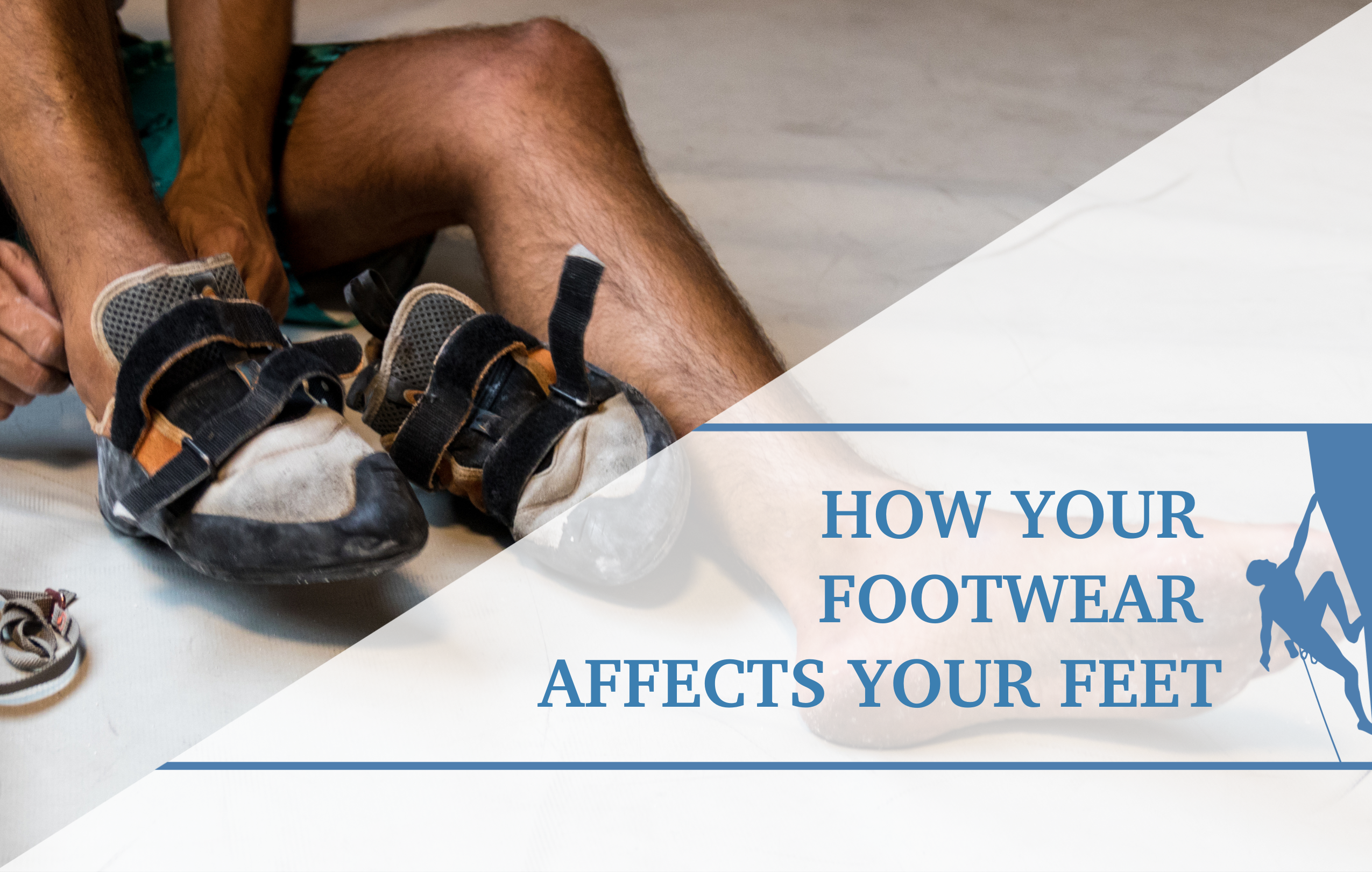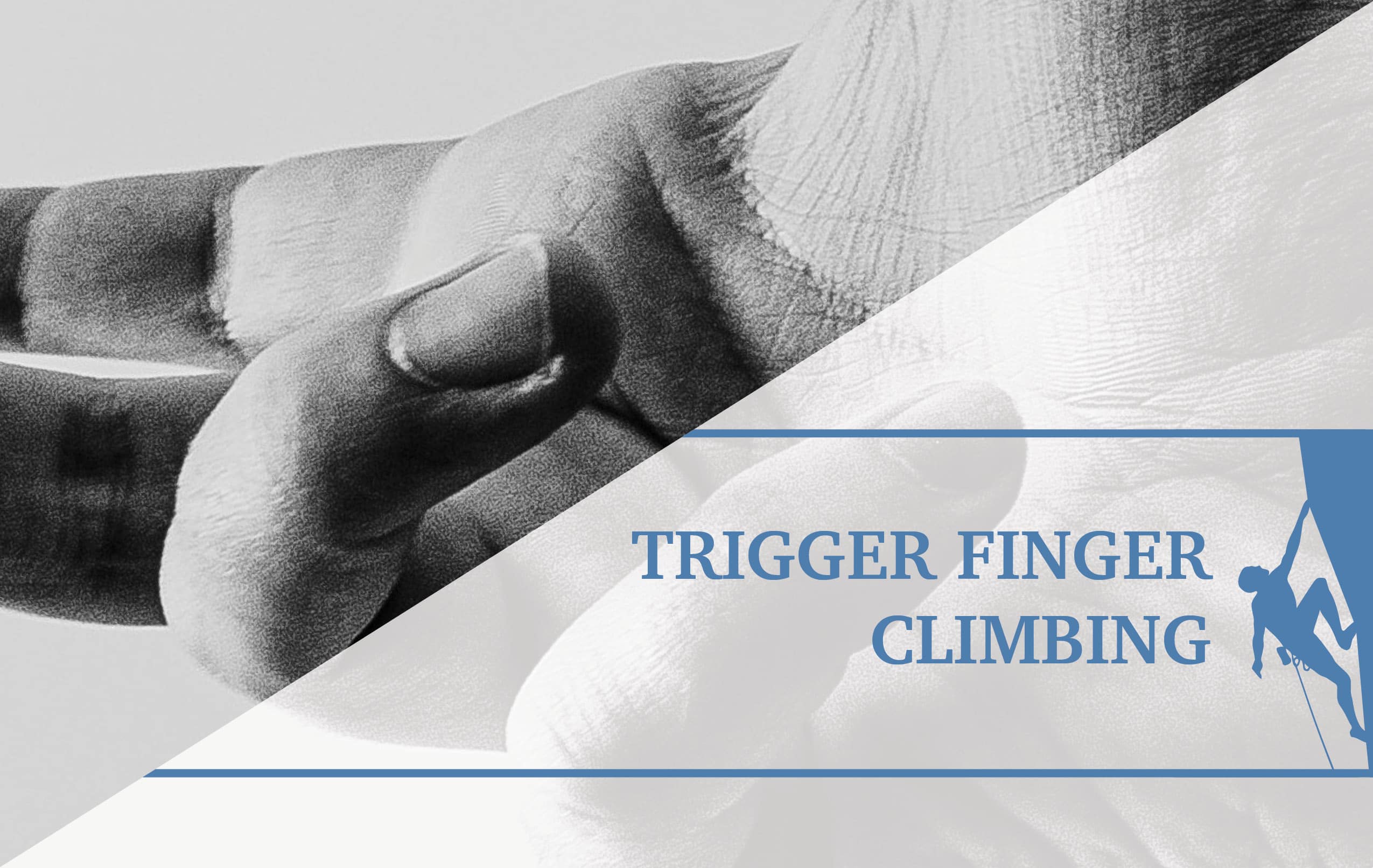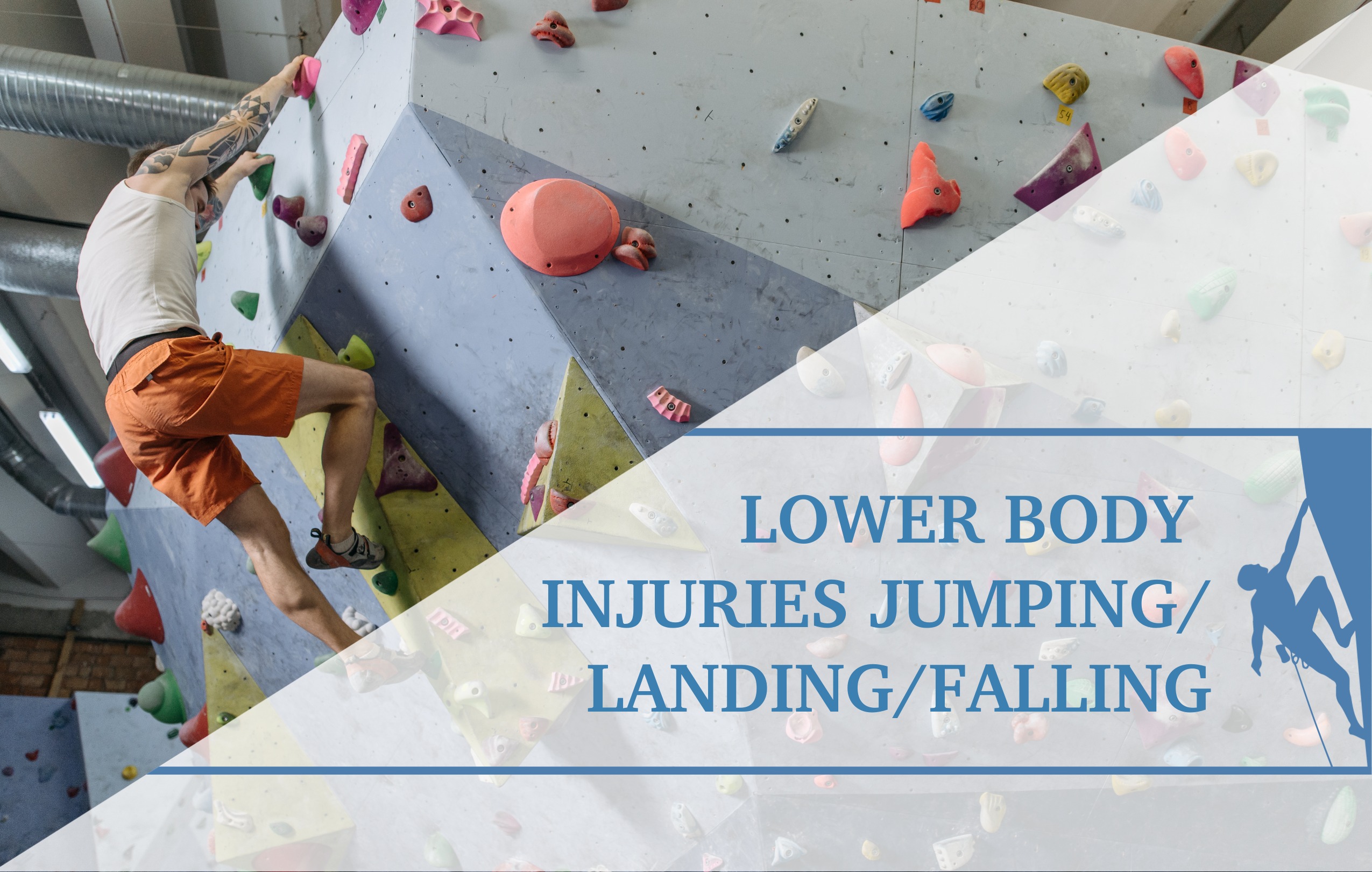Foot Pain Climbing: Choose the Right Shoe

You’re at your local sports store eyeing all the beautiful climbing shoes you probably don’t need (but definitely want). You quickly envision yourself climbing in new shoes – climbing better than you’ve ever climbed before and perhaps, even sending your long-term project. You try on an aggressive shoe, down-turned and stiff with orange accents. Even better, it’s the same shoe you saw Brooke Raboutou wear in the Olympics, so it must be good, right?!
Now that you have them on your feet, you’re puzzled if the shoe, and even shoe size, is right for you. Your feet really hurt in them. But the sales associate, a climber herself, assures you that climbing shoes are supposed to fit this way. Convinced enough, you buy the shoes. As time passes, your feet continue to hurt in them and now even after you take them off. Your feet even start to look different, with new bumps on the back of your heels along with several other changes. You confide in your climbing friends who assure you that it’s totally normal and that their feet actually look “much worse than yours”. You trust your friends and their collective experiences and continue to ignore your feet until you can’t anymore. Maybe your climbing shoes weren’t right for you after all.
Foot pain is a universally accepted and normalized component of climbing. And to be quite frank, it doesn’t and shouldn’t need to be this way. Now, the intention of this article is not to entirely deter people from wearing aggressive, tight shoes but rather to highlight the importance of caring for our feet. While we often spend ample time preparing our fingers, arms, and shoulders to tolerate our sport’s demands, there is very little consideration given to our lower body. Feet, in my humble opinion, are the climber’s unsung hero. They bear much of the load, though are seemingly an afterthought when it comes to being strong, healthy and ultimately pain free.
Among climbers, feet are the third most common body part injured, after finger and forearm injuries1. Common foot deformities and pathologies seen in rock climbers include: hallux valgus, Achilles tendinopathy and Haglund’s deformities, plantar heel pain, and chronic ankle instability. Some of these injuries are a result of traumatic falls but many are injuries caused by training errors, improperly fitted shoes, or most likely a combination of the two.
On average, we wear our climbing shoes 2.3 sizes too small and develop associated foot pain as a consequence1,2. It’s important to parse out the source of pain so the issue can be addressed accordingly. Targeted exercise, activity modification, and knowing how to pick the right shoe can work wonders!
Signs and Symptoms
Listed below are some of the most common foot pathologies found in climbers along with some signs and symptoms, and shoe recommendations for each. It should be noted that many climbers will exhibit some of these foot pathologies and experience no pain, which is also totally normal! So, if this is you, don’t stress, and pay extra attention to the Shoe Recommendations for Every Climber and Intervention sections below. Furthermore, please keep in mind that the pathologies listed below can be complicated to manage and/or easily mistaken for other foot problems. Please seek professional advice from a physical therapist or other licensed health care provider if you have ongoing pain.
Achilles Tendinopathy and Haglund’s deformities
Location:
Pain along the Achilles tendon or at the back of the heel. Bumps on the back of the heel, called Haglund’s deformities, are sometimes associated with Achilles tendinopathy.
Characteristics:
Pain worse after moments of inactivity that improves with movement. Slab climbing or toeing off on a hold will often be painful.
Shoe Recommendations:
– Wider ankle opening that doesn’t constrict or compress the back of the heel
– Less of an aggressive heel for heel hooking
Examples of Shoes to Try:
– Evolv Kira
– Scarpa Helix
Examples of Shoes to Avoid:
– La Sportiva Solution
– Evolv Phantom
Hallux Valgus (bunions)
Location:
Pain at the base of your big toe.
Characteristics:
Big toe will be pointing inwards towards your other toes. Wearing shoes that are especially snug across the mid and forefoot will increase symptoms. Climbers will also experience pain at the base of the big toe with weight bearing on edges.
Shoe Recommendations:
– Wider toe box (most importantly)
– You may prefer a lacing shoe so you can more specifically widen the front of shoe while still being able to tighten the shoe around the ankle
– Some people find relief with using a toe separator throughout the day to reduce pain
Examples of Shoes to Try:
– La Sportiva Skwama
– Butora Acro (wide)
Examples of Shoes to Avoid:
– La Sportiva Miura
– Scarpa Drago
Plantar Heel Pain (plantar fasciitis)
Location:
Pain the bottom of the foot near the back of the arch.
Characteristics:
Plantar heel pain is similar to Achilles tendinopathy in that the pain is often worse after short bouts of inactivity that improve with warm-up. Pain with climbing is often worse with slab climbing or when in positions where the big toe is extended (bent backward) when pushing off a hold. Climbing with softer shoes on edges, or slab climbing will make pain worse.
Shoe recommendations:
– Stiffer shoe (most importantly)
– Rounded shoe that has somewhat of an arch to it
Examples of Shoes to Try:
– La Sportiva Solutions
– Butora Mantra
Examples if shoes to Avoid:
– La Sportiva Mythos
– Five Ten Moccasym
Chronic Ankle Instability
Location:
The initial incident will cause pain on the top or bottom part of the outside of the foot.
Characteristics:
Some individuals will have a feeling of instability, fear of rolling the ankle and or increased difficulty with balance on that foot. Most climbers with chronic ankle instability have sprained their ankle before.
Shoe Recommendations:
Pick a shoe that is bigger, perhaps even a shoe that is your actual street shoe size. When a climber wears shoes that are too small, it puts the ankle in a more down-turned position, which can make it more likely for you to re-roll your ankle.
Intervention
Targeted strengthening exercises need to be incorporated into your training program so that your tissues can be better prepared for all the weight you put through them. Below are some video examples of ways to rehabilitate your feet based on the foot pathologies listed above. These exercises are also great to perform as injury prevention exercises!
Strengthening Exercises for Achilles Tendinopathy
Strengthening Exercises for Hallux Valgus
Strengthening Exercises for Plantar Heel Pain
Strengthening & Balance Exercises for Ankle Instability
Shoe Recommendations for Every Climber
1. Have at least two pairs of climbing shoes—one to wear during lower intensity climbing (warm-up, ARC training, etc.) that is not painful to wear and closer to, if not actually, your street shoe size, and the other to wear only when you’re climbing at higher intensities and pushing your climbing grade.
2. Take your shoes off while belaying or between bouldering routes. Give your feet the break they deserve!
3. Make sure your street shoes fit well to reduce the overall stress you’re putting on them outside of the gym. Mchenry et. al 2015 found that the rock climbers incorrectly sized their street shoe one size too small.
4. Go for the bigger size if you find your feet so painful that you won’t fully bear weight through them while climbing. The more weight you can put through your feet, the less stress you’ll be putting on your fingers and arms.
In order to keep your feet healthy and in tip-top shape, you should implement a combination of good footwear with consistent strength training (using the exercises above). Undoubtedly, us climbers will continue to wear tight shoes when we are looking to climb at high intensities–you know, those moments when you’re going for an on-sight or looking to finally send your project. That being said, challenge yourself to only wear your really small and painful shoes for those moments and those moments only. Pick the comfortable shoe for all your other training and focus on areas of your performance that aren’t equipment-dependent: foot work, upper body strength, power and endurance. This will make you a better climber and your feet will thank you for it later.
About the Author

Kaile Sauro (she/her) is a Doctor of Physical Therapy based out of Missoula, MT. Her interests include rock climbing, running and endurance sport rehabilitation and treating individuals across the lifespan looking to return to activities that make life meaningful to them. Outside of the clinic, you can find Kaile exploring in all forms with her partner and peak-seeking pup Newton in the mountains of Montana! To contact Kaile with questions or comments, please email her at kailesauro@gmail.com .
Citations
- Schöffl V, Küpper T. Feet injuries in rock climbers. World journal of orthopedics. 2013;4(4):218-228. https://pubmed.ncbi.nlm.nih.gov/24147257 https://www.ncbi.nlm.nih.gov/pmc/articles/PMC3801241/. doi: 10.5312/wjo.v4.i4.218.
- Buda R, Di Caprio F, Bedetti L, Mosca M, Giannini S. Foot overuse diseases in rock climbing: An epidemiologic study. J Am Podiatr Med Assoc. 2013;103(2):113-120. https://japmaonline.org/view/journals/apms/103/2/1030113.xml. doi: 10.7547/1030113.
- McHenry RD, Arnold GP, Wang W, Abboud RJ. Footwear in rock climbing: Current practice. The Foot. 2015;25(3):152-158. https://www.sciencedirect.com/science/article/pii/S0958259215000620. doi: https://doi.org/10.1016/j.foot.2015.07.007.
- Disclaimer – The content here is designed for information & education purposes only and the content is not intended for medical advice.





I’ve got a Haglunds deformity that I tried to treat with physical therapy, shockwaves, and exercises for the last year. My heel doesn’t look much different, the bump is quite small and nearly invisible without comparing two feet but it hurts and gets irritated from any pressure on it. I had to switch to more comfortable climbing shoes and used sandpaper to get rid of some rubber on the back of my shoe to make it softer and less painful for me. After all of this, I am still afraid to heel hook with my right leg and regularly feel a big discomfort from any pressure put on the back of my heel. I also can’t do jogging for more than 5k at once, or drive a car in stiff shoes. The doctor recommended platelet plasma injections, but I don’t believe it would help, as it doesn’t get rid of the problem and only could help with soft tissue for some time.
After struggling for last year, trying everything I am close to deciding to have a minimal invasive surgery. I wanted to leave a comment here, maybe there is someone who had a similar experience and could share an opinion, on whether it is worth it and how it is to climb after surgery. What was the recovery time?